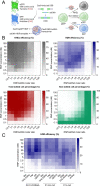Chemical Evolution of Amphiphilic Xenopeptides for Potentiated Cas9 Ribonucleoprotein Delivery
- PMID: 37395536
- PMCID: PMC10360056
- DOI: 10.1021/jacs.3c01902
Chemical Evolution of Amphiphilic Xenopeptides for Potentiated Cas9 Ribonucleoprotein Delivery
Abstract
The introduction of the CRISPR/Cas9 system in the form of Cas9/sgRNA ribonucleoproteins (RNP) is an efficient, straightforward strategy for genome editing, and potent RNP carriers are in high demand. Here, we report a series of artificial peptides based on novel ionizable amino acids that are able to deliver Cas9 RNP into cells very efficiently. Systematic variation of hydrophobic properties revealed a relationship between the xenopeptide logD7.4 and genome editing potency. By correlating the physicochemical properties with biological activity, individual optima were found for different xenopeptide sequence architectures. The optimized amphiphilic carriers enable ∼88% eGFP knockout at an RNP dose of only 1 nM and up to 40% homology-directed repair (HDR) in eGFP/BFP switchable reporter cells by co-delivery with an ssDNA template. Mechanistic studies demonstrated that hydrophobically balanced xenopeptides are more resistant to ionic stress as well as concentration-dependent dissociation and promote endocytosis by both clathrin- and macropinocytosis-mediated pathways. The systematic study develops a versatile and adjustable carrier platform and highlights impactful structure-activity relationships, providing a new chemical guide for the design and optimization of nonviral Cas9 RNP nanocarriers.
Conflict of interest statement
The authors declare no competing financial interest.
Figures





Similar articles
-
Dual pH-responsive CRISPR/Cas9 ribonucleoprotein xenopeptide complexes for genome editing.Eur J Pharm Sci. 2025 Feb 1;205:106983. doi: 10.1016/j.ejps.2024.106983. Epub 2024 Dec 7. Eur J Pharm Sci. 2025. PMID: 39647515
-
CRISPR/Cas9 Ribonucleoprotein Delivery Enhanced by Lipo-Xenopeptide Carriers and Homology-Directed Repair Modulators: Insights from Reporter Cell Lines.Int J Mol Sci. 2025 May 3;26(9):4361. doi: 10.3390/ijms26094361. Int J Mol Sci. 2025. PMID: 40362595 Free PMC article.
-
Lipo-Xenopeptide Polyplexes for CRISPR/Cas9 based Gene editing at ultra-low dose.J Control Release. 2024 Jun;370:239-255. doi: 10.1016/j.jconrel.2024.04.037. Epub 2024 Apr 27. J Control Release. 2024. PMID: 38663751
-
Methods for CRISPR-Cas as Ribonucleoprotein Complex Delivery In Vivo.Mol Biotechnol. 2023 Feb;65(2):181-195. doi: 10.1007/s12033-022-00479-z. Epub 2022 Mar 24. Mol Biotechnol. 2023. PMID: 35322386 Review.
-
[Genome editing in plants directed by CRISPR/Cas ribonucleoprotein complexes].Yi Chuan. 2020 Jun 20;42(6):556-564. doi: 10.16288/j.yczz.20-017. Yi Chuan. 2020. PMID: 32694114 Review. Chinese.
Cited by
-
Discovery of a Peptoid-Based Nanoparticle Platform for Therapeutic mRNA Delivery via Diverse Library Clustering and Structural Parametrization.ACS Nano. 2024 Aug 20;18(33):22181-22193. doi: 10.1021/acsnano.4c05513. Epub 2024 Aug 6. ACS Nano. 2024. PMID: 39105751 Free PMC article.
-
Survival strategies of cancer cells: the role of macropinocytosis in nutrient acquisition, metabolic reprogramming, and therapeutic targeting.Autophagy. 2025 Apr;21(4):693-718. doi: 10.1080/15548627.2025.2452149. Epub 2025 Jan 26. Autophagy. 2025. PMID: 39817564 Free PMC article. Review.
-
Lipopeptide-mediated Cas9 RNP delivery: A promising broad therapeutic strategy for safely removing deep-intronic variants in ABCA4.Mol Ther Nucleic Acids. 2024 Sep 26;35(4):102345. doi: 10.1016/j.omtn.2024.102345. eCollection 2024 Dec 10. Mol Ther Nucleic Acids. 2024. PMID: 39494150 Free PMC article.
-
mCherry on Top: A Positive Read-Out Cellular Platform for Screening DMD Exon Skipping Xenopeptide-PMO Conjugates.Bioconjug Chem. 2023 Dec 20;34(12):2263-2274. doi: 10.1021/acs.bioconjchem.3c00408. Epub 2023 Nov 22. Bioconjug Chem. 2023. PMID: 37991502 Free PMC article.
-
A Facile Method for Assessing Intra Cellular Stability and Co-localization of Cas9 mRNA and sgRNA Using Confocal Microscopy.Methods Mol Biol. 2025;2965:455-466. doi: 10.1007/978-1-0716-4742-4_23. Methods Mol Biol. 2025. PMID: 40877520
References
Publication types
MeSH terms
Substances
LinkOut - more resources
Full Text Sources

